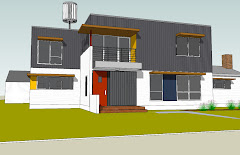We liked the look of the Ipe so much that we changed the design to add more wood to the front entry. We originally planned on finishing off the soffit of the balcony and the entry overhang in a metal or hardi-board flat panel. As we looked at the details, we decided it would add more warm and simplify the material language by finishing off both the soffit and entry canopy in Ipe.

 The canopy soffit has yet to be finished. The upper soffit (thru the tree leaves) is complete with ipe.
The canopy soffit has yet to be finished. The upper soffit (thru the tree leaves) is complete with ipe. Ipe (pronounced E-pay) is a durable teaklike tropical hardwood sold as Ironwood or Pau Lope (pow LOW-pay). Known for its hardness , ipe is more durable than redwood and cedar. It has a life expectancy of 40 years or more, and is resistant to insects and decay. Ipe is sustainably harvested in Brazil and it has a gorgeous reddish-brown color. To maintain the rich walnut color, it will have to be resealed every 1-2 years. If not sealed it will become silver-gray, which still looks good, but just doesn’t have the richness of the sealed wood.
Ipe is not cheap. It can be even higher or similar in cost to redwood- but it is durable, so if you consider the life-cycle costs, that makes it easier to swallow.
For the front entry stair, back stair and balcony flooring, we chose a composite material called Trex. Trex is made of approximately 50% reclaimed wood and 50% reclaimed and recycled plastic. You know those pesky plastic shopping bags you get from the grocery store? Many of them end up in Trex, along with sawdust, wood chips and shavings. The end product has some great advantages over wood:
- never needs sanding, painting or staining
- doesn’t splinter
- the plastic shields it from moisture and insect damage
- the wood protects it from UV damage
- Trex offers a 25 year warranty
- doesn’t use those nasty chemicals that go into pressure treated wood. (note: before getting seduced by the inexpensive pressure-treated pine lumber option, make sure you thoroughly research the chemicals used. There is a lot of literature out there that may cause you to reconsider this as a viable option).
 We choose a reddish color for the Trex that would be compatible with the Ipe. There is will be a bench under the Profilit glass window in the future.
We choose a reddish color for the Trex that would be compatible with the Ipe. There is will be a bench under the Profilit glass window in the future.Again, the composite product is not the cheapest solution- but for maintenance, durability and sustainability, it’s a great choice. Although, we could have used the Ipe for the decking as well, we wanted to demonstrate different materials and test how they will be to maintain over the years. Check back with us in couple of years!



2 comments:
I just became aware of your project (and I apologize if I have missed posts about my comment). It's looking beautiful! However, I am amazed that (and this may due to being in the "under construction phase") many exposed light bulbs in your house are regular old incandescents.
Will your super-green house eventually have compact fluorescents or LEDs wherever possible?
Btw, thanks for doing this blog. It is an amazing resource.
Thanks for the question, because many others were probably wondering this and it would be good to clarify! There are a number of light fixtures that were on back-order, so the electrician just put in temporary fixtures in many places in order to get our occupany certificate.
We also used many standard fixtures and called for CFLs to be installed. Still waiting for that to happen. We do have a couple of LED recessed can lights also- but it's not obvious because they look the same as standard fixtures. In the end, there should not be any incandescent bulbs.
Thanks for the compliments!
Roxanne
Post a Comment